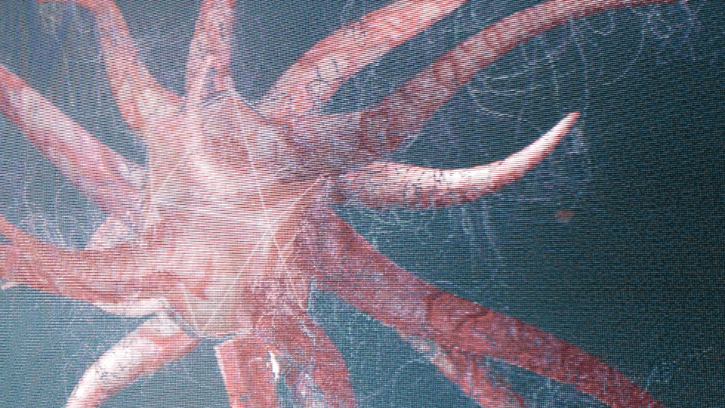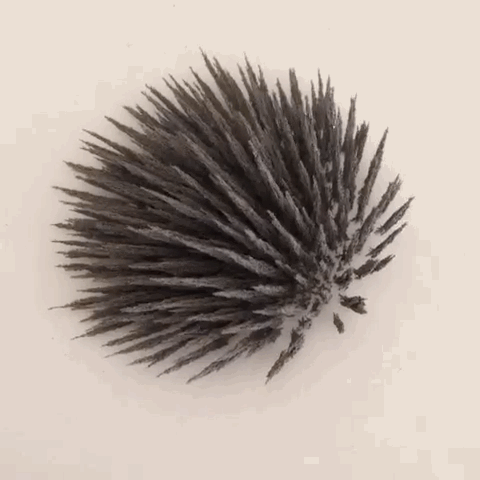The Eclectic Art of the Faculty Show at the Pollock
The faculty show at the Pollock now through February 22
Sandwiched between the video game lounge and the convenience store on the main floor of the Hughes-Trigg Student Center is the Pollock Gallery, now showing an eclectic collection of artwork by Meadows Division of Art faculty through February 22, 2014. This year’s show includes pieces rendered in fabric, paint, etchings, ceramic, cast iron and an assortment that rely on a power source.

There’s more going on here than you think in Ira Greenberg’s ProtoCephalopod: Lifecycle Study 01, 2014. C++, Open GL Code (Protobyte Library)
Walking into the gallery, one can’t help but notice the haunting image on the far wall. Misty Keasler’s Untitled is a rich-toned but curious image of a bone-white… dog? seal? fantastical creature? Its soulful dark eyes seem to look back at you, drawing you in. The piece is an archival pigment photograph of carefully constructed polyurethane foam, inspired by Keasler’s fascination with taxidermy. Normally used as the structure on which taxidermists would drape animal fur, Keasler’s foam creature is simultaneously real and unreal.
“It evokes sympathy and confrontation from the viewer while at the same time remaining completely empty, since we know it’s an inanimate object,” says Keasler. “There is an element of false recognition between the viewer and object. The piece seems familiar but it isn’t. It’s nothing I know in ordinary life.” Keasler adds that the piece reverses the traditional human/animal power play of taxidermy, causing the viewer to become the object of the gaze at every angle.
Occupying the floor space are two pieces, Endless Plumb (Plugged) by Brian Molanphy and Roundish Rock/Roundish Rock Analogue by James Sullivan.
Endless Plumb (Plugged) is named after Endless Column by Constantin Brancusi, according to Molanphy, and is inspired by ceramics that align horizontally, ranging from Han Dynasty cocoon jars to salt-glazed sewer pipes and from Marcel Duchamp to Wouter Dam. “It portrays a real horizontal closure instead of an imagined vertical infinity,” says Molanphy. “Common association of ceramics with geology may suggest gradual, infinite and inevitable fluid deposition, as natural as rock formation; however, the particular obstruction in Endless Plumb (Plugged) is immediate, temporal and politically contingent.”
Some pieces in the show rely on a power source, such as Noah Simblist’s “Cenotaph” slide projections and Mary Walling Blackburn’s wall-mounted e-book, Sister Apple, Sister Pig. Ira Greenberg’s ProtoCephalopod: Lifecycle Study 01, rendered in real-time and created using C++ and OpenGL code, started out as an “egg” when the show opened earlier in February; over the length of the show it grows and develops, including growing a new outer skin. “It matures and then decays and eventually fades away,” says Greenberg. “Every hour a screen capture is automatically taken and put into an online archive, where eventually there will be about 600 images documenting the creature's life.”
Another surprising piece in the show is a rather small piece by Brittany Ransom, titled All this is a dream. Standing in a corner on a black pedestal is a small white box, topped with something that at first looks like carpet or hair, reaching only about an inch and a half into the air. At intermittent times, the “hair,” which is made of lodestone dust, starts to move.

According to Ransom, the piece is a coded system that randomly activates the material on the pedestal via a magnet attached to a motor. The title comes from an 1849 quote from Michael Faraday:
"ALL THIS IS A DREAM. Still examine it by a few experiments. Nothing is too wonderful to be true, if it be consistent with the laws of nature; and in such things as these experiment is the best test of such consistency."
Michael Faraday - laboratory journal entry #10,040 (19 March 1849)
“Ultimately the piece is a very quick experiment that is for a larger series of magnetic driven works that will utilize the same magnetic material,” says Ransom. “The lodestone dust in other works will be manipulated, gathered and shifted using custom magnetic systems driven by live streaming Twitter data.” Ransom has been using Twitter data as a material source and for research for the past year and says this work is a small gesture towards the future pieces in this new series, which is yet to be named.
Eighteen faculty members in all are represented in the exhibit, including Mary Walling Blackburn, Michael Corris, Matthew Cusick, Charles Debus, David Dreyer, Barnaby Fitzgerald, Ira Greenberg, Debora Hunter, Misty Keasler, Travis LaMothe, Michelle Mackey, Brian Molanphy, Brittany Ransom, Don Relyea, Noah Simblist, James Sullivan, Philip Van Keuren and Mary Vernon.
The exhibit, assembled by the faculty of the Division of Art at Meadows School of the Arts, is free of charge and is open Monday, Tuesday, Thursday and Friday 11 a.m. - 5 p.m., and Saturday 1 - 5 p.m.